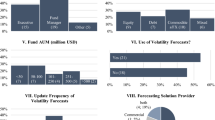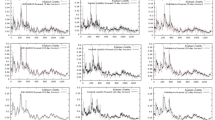Abstract
This study examines whether incorporating volatility improves the forecast of directional changes in the returns of Australia’s banking, industrial and resource sectors. This study first estimates a benchmark non-volatility logit regression model and assesses it against four estimated volatility logit models measured by mean absolute deviation, standard deviation, return squared (U2) and range. An out-of-sample prediction performance, assessed by Brier’s QPS statistic and hit ratio, confirms that volatility improves the prediction of directional changes of returns. A simple trading strategy is utilized to provide practical improvement in investors’ market timing decisions.

Similar content being viewed by others
References
Amemiya, T.: Qualitative response models: a survey. J. Econ. Lit. 19, 1483–1536 (1981)
Anatolyev, S., Gospodinov, L.: Modelling financial return dynamics via decomposition. J. Bus. Econ. Stat. 28, 232–245 (2010)
Anderson, H.M., Vahid, F.: Forecasting the volatility of Australian stock returns: do common factors help? J. Bus. Econ. Stud. 25, 76–90 (2007)
Anneart, J., De Ceuster., M., Valckx, N.: Financial market volatility: informative in predicting recessions. Bank of Finland Discussion Papers vol. 14, Helsinki (2001)
Beenstock, M., Chan, K.: Economic forces in the London stock market. Oxf. Bull. Econ. Stat. 50, 27–39 (1988)
Bekiros, S.D., Georgoutsos, D.: Non-linear dynamics in financial asset returns: the predictive power of the CBOE volatility index. Eur. J. Finance 14, 397–408 (2008)
Benson, K., Faff, R., Smith, T.: Fifty years of finance research in the Asia Pacific Basin. Account. Finance 54, 335–363 (2014)
Benson, K., Clarkson, P., Smith, T., Tutticci, I.: A review of accounting research in the Asia Pacific region. Australian Journal of Management 40, 36–88 (2015)
Bertram, W.K.: An empirical investigation of Australian Stock Exchange data. Physica A 341, 533–546 (2004)
Burdekin, R., Siklos, P.: Enter the dragon: Interactions between Chinese, US and Asia-Pacific equity markets 1995–2010. Pac. Basin Finance J. 20, 521–541 (2012)
Campbell, J., Thompson, S.: Predicting excess stock returns out of sample: can anything beat the historical average? Rev. Financ. Stud. 21, 1509–1531 (2008)
Chaudhuri, K., Smiles, S.: Stock market and aggregate economic activity: evidence from Australia. Appl. Financ. Econ. 14, 121–129 (2004)
Chen, N.-F., Roll, R., Ross, S.: Economic forces and the stock market. J. Bus. 59, 383–403 (1986)
Chen, C.H., Yu, W.C., Zivot, E.: Predicting stock volatility using after-hours information: evidence from the Nasdaq actively traded stocks. Int. J. Forecast. 28, 366–383 (2012)
Cheung, Y.W., Chinn, M., Pascual, G.: Empirical exchange rate models of the nineties: are any fit to survive? University of Santa Cruz, Department of Economics, working paper series qt12z9x4c5, Santa Cruz, CA (2003)
Christoffersen, P., Diebold, F.: Financial assets returns, direction of change forecasting, and volatility dynamics. Manag. Sci. 52, 1273–1287 (2006)
Christoffersen, P., Diebold, F., Marino, R., Tay, R., Tse, Y.: Direction-of-change forecasts based on conditional variance, skewness and kurtosis dynamics: international evidence. J. Financ. Forecast. 1, 3–24 (2007)
Durack, N., Durand, R., Maller, R.: A best choice among asset pricing models? The conditional capital asset pricing model in Australia. Account. Finance 44, 139–162 (2004)
Durand, R., Koh, S., Watson, I.: Who moved Asian-Pacific stock markets? A further consideration of the impact of the US and Japan. Aust. J. Manag. 26, 125–146 (2001)
Durand, R., Scott, D.: iShares Australia: a clinical study in international behavioral finance. Int. Rev. Financ. Anal. 12, 223–239 (2003)
Engle, R.F., Ng, V., Rothschild, M.: Asset pricing with a factor ARCH covariance structure: empirical estimates for Treasury bills. J. Econ. 45, 213–239 (1990)
Engle, R.F., Susmel, R.: Common volatility in international equity markets. J. Bus. Econ. Stat. 11, 167–176 (1993)
Eun, C., Shim, S.: International transmission of stock market movements. J. Financ. Quant. Anal. 24, 241–256 (1989)
Faust, J., Wright, J.: Efficient prediction of excess returns. Rev. Econ. Stat. 93, 647–659 (2011)
Fama, E., French, K.: Common risk factors in the returns on stocks and bonds. J. Financ. Econ. 33, 3–56 (1993)
Ferson, W., Harvey, C.: The variations of economic risk premium. J. Polit. Econ. 99, 385–415 (1991)
Forbes, K., Rigobon, R.: No contagion, only interdependence: measuring stock market comovements. J. Finance 57, 2223–2261 (2002)
Gallo, G., Otranto, E.: Volatility spillovers, interdependence and comovements: a Markow switching approach. Comput. Stat. Data Anal. 52, 311–326 (2008)
Gencay, R.: Optimization of technical trading strategies and the profitability in security markets. Econ. Lett. 59, 249–254 (1998)
Ghosh, A., Saidi, R., Johnson, K.: Who moves the Asia-Pacific stock markets—US or Japan? Empirical evidence based on the theory of cointegration. Financ. Rev. 34, 159–169 (1999)
Groenewold, N., Fraser, P.: Share prices and macroeconomic factors. J. Bus. Finance Account. 24, 1367–1383 (1997)
Hong, Y., Chung, J.: Are the directions of stock price changes predictable?. Cornell University, Ithaca (2003)
Humpe, A., Macmillan, P.: Can macroeconomic variables explain long term stock market movements? A comparison of the US and Japan. Appl. Financ. Econ. 19, 111–119 (2009)
Jagannathan, R., Wang, Z.: The conditional CAPM and the cross-section of expected returns. J. Finance 51, 3–53 (1996)
Kalev, P., Liu, W.-M., Pham, P., Jarnecic, E.: Public information arrival and volatility of intraday stock returns. J. Bank. Finance 28, 1441–1467 (2004)
Kauppi, H., Saikkonen, P.: Predicting US recessions with dynamic binary response models. Rev. Econ. Stat. 90, 777–791 (2008)
Kazi, M.: Systematic risk factors for Australian stock market returns: a cointegration analysis. Aust. Account. Bus. Finance J. 2, 89–101 (2008)
Knight, F.H.: Risk, uncertainty, and profit. Hart, Schaffner and Marx, Houghton Mifflin Co, Boston (1921)
Kuan, C.M., Liu, T.: Forecasting exchange rates using feed-forward and recurrent neural networks. J. Appl. Econ. 10, 347–364 (1995)
Kulendran, N., Wong, K.: Determinants versus composite leading indicators in predicting turning points in growth cycle. J. Travel Res. 50, 415–430 (2011)
Larsen, G.A., Wozniak, G.: Market timing can work in the real world. J. Portfolio Manag. 21, 74–81 (1995)
Lee, S.B., Kim, K.: Does the October 1987 crash strengthen the co-movements among national stock markets? Rev. Financ. Econ. 3, 89–102 (1993)
Leitch, G.J., Tanner, J.: Economic forecast evaluation: profit versus the conventional error measures. Am. Econ. Rev. 81, 580–590 (1991)
Leung, M., Daouk, H., Chen, A.-S.: Forecasting stock indices: a comparison of classification and level estimation models. Int. J. Forecast. 16, 173–190 (2000)
Lo, A.W., MacKinlay, A.G.: Stock market prices do not follow random walks: evidence from a simple specification test. Rev. Financ. Stud. 1, 41–66 (1988)
Maddala, G.S.: Introduction to Econometrics. Wiley, Chichester (2001)
Mian, G.M., Adam, C.M.: Volatility dynamics in high frequency financial data: an empirical investigation of the Australian equity returns. Appl. Financ. Econ. 11, 341–352 (2001)
Mukherjee, T.K., Naka, A.: Dynamic relations between macroeconomic variables and the Japanese stock market: an application of a vector error correction model. J. Financ. Res. 18, 223–237 (1995)
Nyberg, H.: Forecasting the direction of the US stock market with dynamic binary probit models. Int. J. Forecast. 27, 561–578 (2011)
Nyberg, H., Ponka, H.: International sign predictability of stock returns: the role of the United States. Econ. Model. 58, 323–338 (2016)
Peirson, G., Brown, R., Easton, S., Howard, P., Pinder, S.: Business Finance, 12th edn. McGraw-Hill, New York City (2015)
Pesaran, M.H., Timmerman, A.: Predictability of stock return: robustness and economic significance. J. Finance 50, 1201–1228 (1995)
Pesaran, M.H., Timmerman, A.: Recursive modelling approach to predicting UK stock returns. Econ. J. 110, 159–191 (2000)
Pindyck, S.R., Rubinfeld, L.: Econometric Models and Economic Forecasts. McGraw-Hill, New York City (1998)
Phylaktis, K.: Capital markets integration in the pacific-based region: an analysis of real interest rate linkage. Pac. Basin Finance J. 5, 195–213 (1997)
Ponka, H.: Real oil prices and the international sign predictability of stock returns. Finance Res. Lett. 17, 79–87 (2016)
Ragunathan, V., Faff, R., Brooks, R.D.: Correlations, business cycles and integration. J. Int. Financ. Mark. Inst. Money 9, 75–95 (1999)
Rapach, D.E., Strauss, J.K., Zhou, G.: International stock return predictability: what is the role of the United States? J. Finance 68, 1633–1662 (2013)
Rydberg, T.H., Shephard, N.: Dynamics of trade-by-trade price movements: decomposition and models. J. Financ. Econ. 1, 2–25 (2003)
Shamsuddin, F.M.: Interest rate and exchange rate risk exposure of Australian banks: a note. Int. J. Bank. Finance 6, 128–138 (2009)
Taylor, N.: A note on the importance of overnight information in risk management models. J. Bank. Finance 31, 161–180 (2007)
Theodossiou, P., Lee, U.: Mean and volatility spillovers across major national stock markets: further empirical evidence. J. Financ. Res. 16, 337–350 (1993)
Todorova, T., Soucek, M.: Overnight information flow and realized volatility forecasting. Finance Res. Lett. 11, 1–9 (2014)
Tsiakas, I.: Overnight information and stochastic volatility: a study of European and US stock exchanges. J. Bank. Finance 32, 251–268 (2008)
Wagner, J., Shellacs, S., Paul, R.: Market timing works where it matters most: in real the world. J. Portf. Manag. 18, 86–90 (1992)
White, H.: A reality check for data snooping. Econometrica 68, 1097–1126 (2000)
Womack, K.L.: Do brokerage analysts’ recommendations have investment value? J. Finance 51, 137–167 (1996)
Acknowledgements
We would like to thank the editor Markus Schmid and the anonymous referees for their constructive recommendations, which helped to improve the quality of this paper. In addition, we would like to thank the feedback received during prior drafts from colleagues Dr. Guneratne Wickremasinghe and Dr. Ranjtih Ihalanayake.
Author information
Authors and Affiliations
Corresponding author
Additional information
Publisher's Note
Springer Nature remains neutral with regard to jurisdictional claims in published maps and institutional affiliations.
Rights and permissions
About this article
Cite this article
Erdugan, R., Kulendran, N. & Natoli, R. Incorporating financial market volatility to improve forecasts of directional changes in Australian share market returns. Financ Mark Portf Manag 33, 417–445 (2019). https://doi.org/10.1007/s11408-019-00338-z
Published:
Issue Date:
DOI: https://doi.org/10.1007/s11408-019-00338-z




